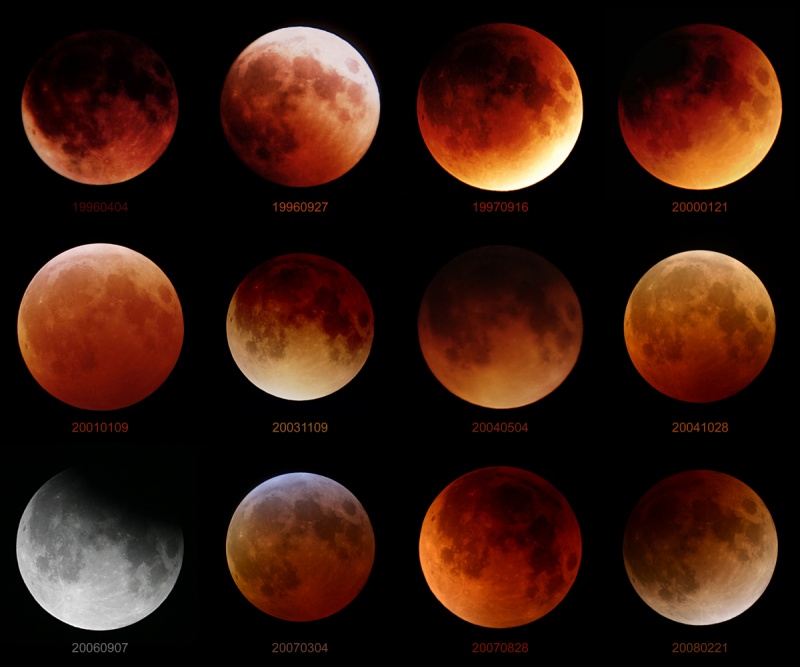Astronomy Picture of the Day
Discover the cosmos! Each day a different image or photograph of our fascinating universe is featured, along with a brief explanation written by a professional astronomer.
Credit & Copyright: Tunç Tezel (TWAN)
Explanation: Welcome to the extra day in the Gregorian Calendar's leap year 2008! To celebrate, consider this grid of lunar eclipse pictures - starting in leap year 1996 and ending with February's eclipse - with the date in numerical year/month/day format beneath each image. Mostly based on visibility from a site in Turkey, the 3x4 matrix includes 11 of the 13 total lunar eclipses during that period, and fills out the grid with the partial lunar eclipse of September 2006. Still, as the pictures are at the same scale, they illustrate a noticeable variation in the apparent size of the eclipsed Moon caused by the real change in Earth-Moon distance around the Moon's elliptical orbit. The total phases are also seen to differ in color and darkness. Those effects are due to changes in cloud cover and dust content in the atmosphere reddening and refracting sunlight into Earth's shadow. Of course, the next chance to add a total lunar eclipse to this grid will come at the very end of the decade.
Total Solar Eclipse 2006 |
Total Solar Eclipse - Observed from Manavgat, Turkey - 29 March 2006
By Odd Høydalsvik, Bergen, Norway

Montage showing the phases of the total solar eclipse in Turkey, 29th March 2006.
Montasje som viser fasene i den totlae solformørkelsen i Tyrkia 29 Mars 2006.

The picture above is a sandwich of two pictures, one of the sun taken just before the eclipse, and one at the start of totality. It shows the difference in size between the sun and the moon at the day of the eclipse. The yellow disk is the sun as it would have been behind the moon, the black ring is the moon. The moon was quite close to the earth, therefore it looks bigger than the sun. Thanks to this, the duration of the eclipse was quite long.
Bildet over er en motasje som viser størrelsesforholdet mellom sola og månen på den dagen formørkelsen fant sted. Den oransje sirkelen er sola slik den ville vært bak månen, den svarte ringen er månen. Månen var ganske nær jorda, derfor har den en del større utstrekning enn sola. Dermed varte formørkelsen ganske lenge.

The picture above shows the corona. It is a composite made of 4 different exposures ranging from 1/125s to 1/4s.
This shape of the corona is typical for periods with low solar activity.
Bildet over viser koronaen til sola. Det er en sammenkopiering av 4 bilder med eksponeringstider fra 1/125s til 1/4s.
Denne langstrakte fasongen på koronaen er typisk for perioder med lav solaktivitet.

The picture above shows the corona further processed in order to show more details. It is a composite made of 4 different exposures ranging from 1/250s to 1/4s.
Bildet over er ytterligere prosessert for å framheve detaljene i koronaen ennå bedre. Det består av 4 eksponeringer fra 1/250s til 1/4s.

The picture above shows several images of the diamond ring taken in rapid sequence before (left) and after (right) totality. We can also see Baileys beeds on second image from left and on first, second and third image from right. These are formed by the sun shining through valleys on the moon limb. The picture is a composite consisting of 9 images combined in Photoshop CS2.
Bildet over viser flere bilder av diamantringen tatt i rask rekkefølge like før (venstre) og etter totaliteten. Vi kan også se såkalte "Baileys beeds" (perlekjede) på andre bilde fra venstre og på første, andre og tredje bilde fra høyre. Disse "perlene" dannes ved at sola skinner gjennom daler på måneranda. Bildet er satt sammen av 9 forskjellige bilder vha Photoshop CS2.

Diamond ring just before totality. 13:55:04 UT+3
Diamantringen like før totalitet. 13:55:04 lokal tid.
Exposure: 1/1000s, f 11, ISO 400

Corona near sun. 13:55:27 UT+3
Koronaen nær solskiva. 13:55:27 lokal tid.
Exposure: 1/125s, f 11, ISO 400

Outer parts of Corona. 13:55:42 UT+3
Ytre deler av koronaen. 13:55:42 lokal tid.
Exposure: 1/4s, f 11, ISO 400

Diamond ring at end of totality. 13:58:57 UT+3
Diamantringen ved slutten av totaliteten. 13:58:53 lokal tid.
Exposure: 1/1000s, f 11, ISO 400

Composite of two images at beginning and end of totality, showing prominences at both sides of sun.
Montasje av to bilder fra begynnelsen og slutten av formørkelsen. Vi kan da se protuberansene på begge sidene av sola.

The thin pink line along part of the sun's limb is the sun's chromosphere.
Den tynne rosa linja langs deler av solranda er kromosfæren til sola.
Common technical data for all pictures above:
Camera: Canon EOS 20D
Lens: Sigma 100-300mm EX APO HSM f1:4 plus Sigma EX APO 2X Tele Converter (600mm)

Multiple exposure on a single frame of slides film.
I forgot to remove the solar filter during totality, so I had to insert another image of the sun here taken with another camera.
Camera: Canon Rebel G / EOS 500N
Lens: EF 28-105mm at 45mm
Exposure: 1/30s, f 8.0 at ISO 100
Film: Fuji Sensia 100
Image at totality is exposed at 1/15s, f 11 at ISO 400 and scaled to correct size before combining in Photoshop.
The following pictures are taken with a Sony DSC-W1 digital compact camera.
 |  |
| In the foreground you can see images of the sun produced by pinhole effect through foliage. | Notice that after totality the direction of the images are reverse. |
Back to main page



No comments:
Post a Comment